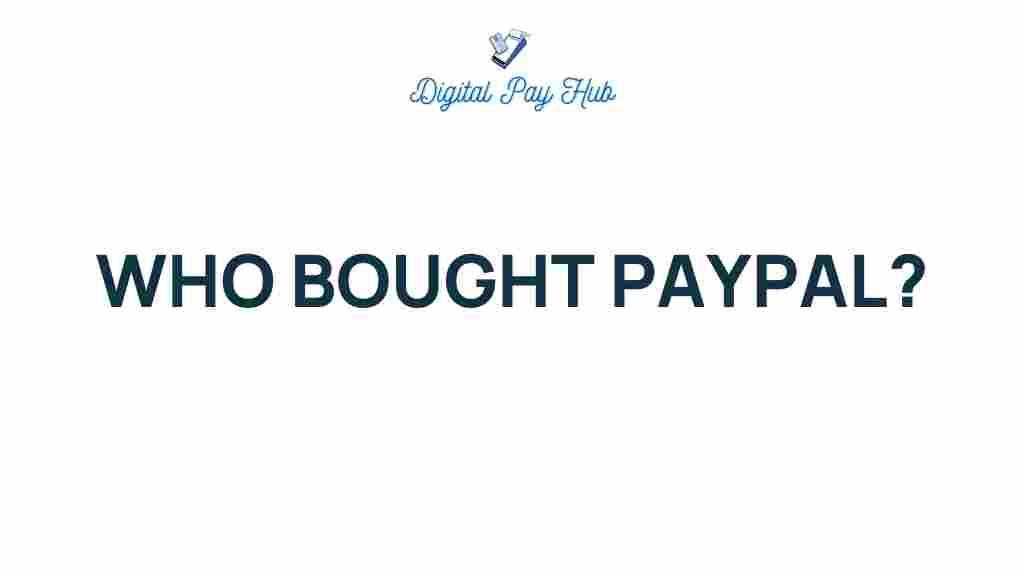Unveiling the Mystery: Who Really Bought PayPal?
The digital landscape of finance has been significantly shaped by various mergers and acquisitions, particularly in the realm of financial technology. One of the most notable events was the PayPal acquisition, which transformed the tech industry and set the stage for future investment trends. In this article, we will delve into the details surrounding the acquisition of PayPal, exploring who bought it, the implications for the e-commerce sector, and the broader corporate strategies that influenced this landmark deal.
Understanding PayPal’s Journey
Founded in 1998, PayPal started as Confinity, a company focused on developing security software for handheld devices. Soon after, it shifted its focus to a digital wallet service. In 2000, Confinity merged with X.com, an online bank founded by Elon Musk. By 2001, the company rebranded itself as PayPal, quickly becoming a leader in online payment solutions.
In 2002, PayPal was acquired by eBay for $1.5 billion in stock. This acquisition was pivotal, as it allowed eBay to integrate PayPal as its primary payment service, thus enhancing the user experience and streamlining transactions on the platform. The move was significant not only for eBay but also for the entire financial technology landscape.
The PayPal Acquisition: Key Players
eBay’s acquisition of PayPal was a strategic decision influenced by various factors:
- Market Position: eBay recognized the growing trend of online shopping and the need for a reliable payment solution.
- Technology Integration: The merger allowed eBay to offer a user-friendly payment method, which was crucial for its marketplace.
- Competitive Edge: By acquiring PayPal, eBay aimed to outpace competitors who lacked a robust payment system.
Impact on the Tech Industry
The acquisition of PayPal set a precedent in the tech industry, particularly in how companies approached mergers and acquisitions. It highlighted several key trends:
- Focus on User Experience: Companies began to prioritize seamless payment integration into their platforms.
- Expansion of Services: Acquiring payment solutions became a strategic move for e-commerce businesses looking to enhance their service offerings.
- Investment in Financial Technology: The deal spurred increased investment in the fintech sector, leading to the emergence of numerous startups offering innovative payment solutions.
PayPal’s Evolution Post-Acquisition
After the acquisition by eBay, PayPal continued to grow and innovate, expanding its services beyond simple payment processing. Some significant developments included:
- International Expansion: PayPal entered various global markets, adapting its services to meet local needs.
- Mobile Payments: With the rise of smartphones, PayPal launched mobile payment solutions that catered to the changing consumer behavior.
- Partnerships and Integrations: PayPal formed partnerships with numerous e-commerce platforms, allowing for easy integration and increased user adoption.
The Spin-Off and Independence
In 2015, eBay made the strategic decision to spin off PayPal into a separate publicly traded company. This move allowed PayPal to focus on its core mission of providing payment solutions without the constraints of being tied to eBay’s marketplace. The spin-off was met with positive market reactions and positioned PayPal to pursue new opportunities independently.
Investment Trends Following PayPal’s Spin-Off
The separation from eBay marked a new chapter for PayPal and influenced various investment trends in the tech industry:
- Increased Valuation: Post-spin-off, PayPal’s valuation soared, reflecting investor confidence in its business model.
- Fintech Boom: The success of PayPal encouraged investors to explore and fund other fintech startups, leading to a wave of innovation.
- Strategic Acquisitions: PayPal began acquiring smaller fintech companies to enhance its product offerings, including Braintree and Venmo.
Troubleshooting Tips: Understanding PayPal’s Corporate Strategies
For businesses looking to understand how PayPal navigated its acquisition and subsequent independence, here are some corporate strategies they employed:
- Adaptability: PayPal continuously adapted its services to meet the evolving needs of consumers and businesses.
- Customer-Centric Approach: The company prioritized user feedback and experiences, integrating changes that improved satisfaction.
- Strategic Partnerships: Collaborations with key players in the tech and e-commerce sectors enabled PayPal to expand its reach effectively.
The Future of PayPal in the E-Commerce Landscape
As the world of e-commerce continues to evolve, PayPal remains a pivotal player in shaping the future of online transactions. Its ability to innovate and respond to market trends positions it as a leader in the fintech space. Some future trends to watch include:
- Cryptocurrency Integration: PayPal’s recent ventures into cryptocurrency transactions may redefine digital payments.
- AI and Machine Learning: The incorporation of AI will enhance fraud detection and improve user experiences.
- Global Payment Solutions: Expanding services to emerging markets will be crucial for PayPal’s growth.
Conclusion: The Legacy of the PayPal Acquisition
The PayPal acquisition by eBay marked a significant milestone in the tech industry, influencing how companies approach payments and consumer transactions. The strategic decisions made during the acquisition, spin-off, and beyond have shaped PayPal into a formidable entity in the financial technology sector. As we look to the future, PayPal’s ongoing innovations and adaptations will continue to impact investment trends and corporate strategies across the tech and e-commerce landscapes.
For more insights on corporate strategies in the tech industry, be sure to check out our article on emerging investment trends. To stay updated on the latest developments in financial technology, visit FinTech News.
This article is in the category Payments and created by DigitalPayHub Team
